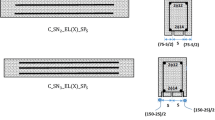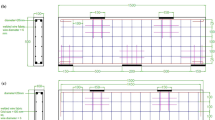Abstract
A non-linear finite-element model was developed to evaluate the flexural behavior of concrete beams, heat-damaged by exposure to elevated temperatures (300–600 °C) before being repaired using different configurations of near surface-mounted carbon-fiber-reinforced polymer strips. The model was validated using reliable experimental data before being employed for predicting flexural performance of heat-damaged beams, cast originally using normal, weight concrete of varying strength grades (25–55 MPa), then repaired with different numbers, spacings, locations (at soffit and on sides) and extension lengths (100–450 mm) of the composite strips. The repaired and heat-damaged concrete beams performed significantly better when being originally cast with a higher strength class of concrete. The results indicate that using a higher number of strips is more beneficial for intact beams and those heat-damaged at intermediate temperatures of 300 and 400 °C with residual ranges for load capacity of (111–121), (108–128) and (126–148) % for the cases of 1, 2 and 3 strips, respectively. It was asserted that inserting two composite strips at a groove spacing less than 50 mm undermined the benefit from repair, especially for heat-damaged beams. The study accentuated the advantages of inserting the composite strips on the sides of the beams instead of their soffits, as well as extending these strips towards the end supports, especially in heat-damaged beams.















Similar content being viewed by others
References
Zhai Y, Deng Z, Li N, Xu R (2014) Study on compressive mechanical capabilities of concrete after high temperature exposure and thermo-damage Constitutive Model. Constr Build Mater 68:777–782. https://doi.org/10.1016/j.conbuildmat.2014.06.052
Cho H-C, Han S-J, Heo I, Kang H, Kang W-H, Kim KS (2020) Heating temperature prediction of concrete structure damaged by fire using a Bayesian approach. Sustainability 12:4225. https://doi.org/10.3390/su12104225
Choi EG, Shin Y-S, Kim HS (2013) Structural damage evaluation of reinforced concrete beams exposed to high temperatures. J Fire Prot Eng 23:135–151. https://doi.org/10.1177/1042391512474666
Hsu J-H, Lin C-S, Huang C-B (2006) Modeling the effective elastic modulus of RC beams exposed to fire. J Mar Sci Technol 14:102–108. https://doi.org/10.51400/2709-6998.2063
Jiangtao YU, Zhaoudao LU, Kai X (2011) Experimental study on the performance of RC continuous members in bending after exposure to fire. Proc Eng 14:821–829. https://doi.org/10.1016/j.proeng.2011.07.104
Kodur VKR, Agrawal A (2016) An approach for evaluating residual capacity of reinforced concrete beams exposed to fire. Eng Struct 110:293–306. https://doi.org/10.1016/j.engstruct.2015.11.047
Täljsten B, Blanksvärd T (2007) Mineral-based bonding of Carbon FRP to strengthen concrete structures. J Compos Constr 11:120–128. https://doi.org/10.1061/(asce)1090-0268(2007)11:2(120)
Karayannis CG, Chalioris CE, Sirkelis GM (2008) Local retrofit of exterior RC Beam–column joints using thin RC jackets—an experimental study. Earthq Eng Struct Dyn 37:727–746. https://doi.org/10.1002/eqe.783
Ma C-K, Apandi NM, Sofrie CS, Ng JH, Lo WH, Awang AZ, Omar W (2017) Repair and rehabilitation of concrete structures using confinement: a review. Constr Build Mater 133:502–515. https://doi.org/10.1016/j.conbuildmat.2016.12.100
Raza S, Khan MK, Menegon SJ, Tsang H-H, Wilson JL (2019) Strengthening and repair of reinforced concrete columns by jacketing: state-of-the-art review. Sustainability 11:3208. https://doi.org/10.3390/su11113208
Buchan PA, Chen JF (2007) Blast resistance of FRP composites and polymer strengthened concrete and masonry structures – a state-of-the-art review. Compos B Eng 38:509–522. https://doi.org/10.1016/j.compositesb.2006.07.009
Dong J, Wang Q, Guan Z (2013) Structural behaviour of RC beams with external flexural and flexural–shear strengthening by FRP Sheets. Compos B Eng 44:604–612. https://doi.org/10.1016/j.compositesb.2012.02.018
Kara IF, Ashour AF (2012) Flexural performance of FRP reinforced concrete beams. Compos Struct 94:1616–1625. https://doi.org/10.1016/j.compstruct.2011.12.012
Obaidat YT, Heyden S, Dahlblom O (2010) The effect of CFRP and CFRP/Concrete Interface Models when modelling retrofitted RC beams with FEM. Compos Struct 92:1391–1398. https://doi.org/10.1016/j.compstruct.2009.11.008
Haddad RH, Al-Rousan RZ (2016) An anchorage system for CFRP strips bonded to thermally shocked concrete. Int J Adhes Adhes 71:10–22. https://doi.org/10.1016/j.ijadhadh.2016.08.003
Arduini M, Nanni A (1997) Parametric study of beams with externally bonded FRP reinforcement. ACI Struct J 94:493–501. https://doi.org/10.14359/499
Morsy A, Helmy K, El-Ashkar N, Nada M (2014) Flexural strengthening for R.C. beams using CFRP sheets with different bonding schemes. In: Grantham M, Basheer PAM, Magee BJ, Soutsos M (eds) Concrete solutions 2014, 1st edn. CRC Press, Boca Raton, pp 313–320
Kara IF, Ashour AF, Köroğlu MA (2016) Flexural performance of reinforced concrete beams strengthened with prestressed near-surface-mounted FRP reinforcements. Compos B Eng 91:371–383. https://doi.org/10.1016/j.compositesb.2016.01.023
Sharaky IA, Torres L, Comas J, Barris C (2014) Flexural response of reinforced concrete (RC) beams strengthened with near surface mounted (NSM) fibre-reinforced polymer (FRP) bars. Compos Struct 109:8–22. https://doi.org/10.1016/j.compstruct.2013.10.051
Zhang SS, Yu T, Chen GM (2017) Reinforced concrete beams strengthened in flexure with near-surface mounted (NSM) CFRP STRIPS: current status and research needs. Compos B Eng 131:30–42. https://doi.org/10.1016/j.compositesb.2017.07.072
Bilotta A, Ceroni F, Di Ludovico M, Nigro E, Pecce M, Manfredi G (2011) Bond efficiency of EBR and NSM FRP systems for strengthening concrete members. J Compos Constr 15:757–772. https://doi.org/10.1061/(asce)cc.1943-5614.0000204
Bilotta A, Ceroni F, Nigro E, Pecce M (2015) Efficiency of CFRP NSM strips and EBR plates for flexural strengthening of RC beams and loading pattern influence. Compos Struct 124:163–175. https://doi.org/10.1016/j.compstruct.2014.12.046
Triantafyllou GG, Rousakis TC, Karabinis AI (2018) Effect of patch repair and strengthening with EBR and NSM CFRP laminates for RC beams with low, medium and heavy corrosion. Compos Struct 133:101–111. https://doi.org/10.1016/j.compositesb.2017.09.029
Hawileh RA (2012) Nonlinear finite element modeling of RC beams strengthened with NSM FRP rods. Constr Build Mater 27:461–471. https://doi.org/10.1016/j.conbuildmat.2011.07.018
Hawileh RA, Naser MZ, Abdalla JA (2013) Finite element simulation of reinforced concrete beams externally strengthened with short-length CFRP plates. Compos B Eng 45:1722–1730. https://doi.org/10.1016/j.compositesb.2012.09.032
Hawileh RA, Musto HA, Abdalla JA, Naser MZ (2019) Finite element modeling of reinforced concrete beams externally strengthened in flexure with side-bonded FRP Laminates. Compos B Eng 173:106952. https://doi.org/10.1016/j.compositesb.2019.106952
Omran HY, El-Hacha R (2012) Nonlinear 3D finite element modeling of RC beams strengthened with prestressed NSM-CFRP STRIPS. Constr Build Mater 31:74–85. https://doi.org/10.1016/j.conbuildmat.2011.12.054
Zhang SS, Teng JG (2015) End cover separation in RC beams strengthened in flexure with bonded FRP reinforcement: Simplified Finite Element Approach. Mater Struct 49:2223–2236. https://doi.org/10.1617/s11527-015-0645-z
Almusallam T, Al-Salloum Y, Elsanadedy H, Alshenawy A, Iqbal R (2018) Behavior of FRP-strengthened RC beams with large rectangular web openings in flexure zones: Experimental and numerical study. Int J Concr Struct Mater 12:47. https://doi.org/10.1186/s40069-018-0272-5
Salih R, Zhou F, Abbas N, Khan Mastoi A (2020) Experimental investigation of reinforced concrete beam with openings strengthened using FRP sheets under cyclic load. J Mater 13:3127. https://doi.org/10.3390/ma13143127
Kadhim MMA, Jawdhari AR, Altaee MJ, Adheem AH (2020) Finite Element Modelling and parametric analysis of FRP strengthened RC beams under impact load. J Build Eng 32:101526. https://doi.org/10.1016/j.jobe.2020.101526
Firmo JP, Arruda MRT, Correia JR, Rosa IC (2018) Three-dimensional finite element modelling of the fire behaviour of insulated RC beams strengthened with EBR and NSM CFRP STRIPS. Compos Struct 183:124–136. https://doi.org/10.1016/j.compstruct.2017.01.082
Gawil B, Wu H-C, Elarbi A (2020) Modeling the behavior of CFRP strengthened concrete beams and columns at different temperatures. Fibers 8:10. https://doi.org/10.3390/fib8020010
Al-Rousan RZ, Haddad RH (2013) NLFEA sulfate-damage reinforced concrete beams strengthened with FRP Composites. Compos Struct 96:433–445. https://doi.org/10.1016/j.compstruct.2012.09.007
Jadooe A, Al-Mahaidi R, Abdouka K (2017) Experimental and numerical study of strengthening of heat-damaged RC beams using NSM CFRP strips. Constr Build Mater 154:899–913. https://doi.org/10.1016/j.conbuildmat.2017.07.202
Haddad RH, Obaidat YT (2018) A nonlinear finite-element model for shear-deficient heat-damaged concrete beams repaired using NSM CFRP strips. Constr Build Mater 170:314–325. https://doi.org/10.1016/j.conbuildmat.2018.03.084
Alkhraisha H, Mhanna H, Tello N, Abed F (2020) Serviceability and flexural behavior of concrete beams reinforced with basalt fiber-reinforced polymer (BFRP) bars exposed to harsh conditions. Polymers 12:2110. https://doi.org/10.3390/polym12092110
Haddad RH, Gharaibeh LH, Almomani OA (2022) The behavior of concrete beams strengthened with NSM CFRP strips: a numerical parametric study. J Adhes Sci Technol. https://doi.org/10.1080/01694243.2022.2057105
SIMULIA (2011) Abaqus Theory Manual (6.11). Dassault Systems SIMULIA Corporation, Providence, Rhode Island, USA
Haddad RH, Almomani OA (2017) Recovering flexural performance of thermally damaged concrete beams using NSM CFRP strips. Constr Build Mater 154:632–643. https://doi.org/10.1016/j.conbuildmat.2017.07.211
Haddad RH, Almomani OA (2018) Flexural performance and failure modes of NSM CFRP-strengthened concrete beams: a parametric study. Int J Civ Eng 17:935–948. https://doi.org/10.1007/s40999-018-0342-8
Bahr O, Schaumann P, Bollen B, Bracke J (2013) Young’s modulus and Poisson’s ratio of concrete at high temperatures: Experimental investigations. Mater Des 45:421–429. https://doi.org/10.1016/j.matdes.2012.07.070
ACI Committee 318 (2019) Building Code Requirements for Structural Concrete (ACI 318–19) and Commentary on Building Code Requirements for Structural Concrete (ACI 318R-19), Farmington Hills, MI
Technical Committee CEN/TC250 "Structural Eurocodes" (2004) Eurocode 2: Design of concrete structures - Part 1-2: General rules - Structural fire design. BSI, London
Haddad R, Al-Rabadi E (2021) NLFE modeling of bond between NSM CFRP strips and heat-damaged concrete. J Adhes Sci Technol. https://doi.org/10.1080/01694243.2021.2000107
Chang YF, Chen YH, Sheu MS, Yao GC (2006) Residual stress–strain relationship for concrete after exposure to high temperatures. Cem Concr Res 36:1999–2005. https://doi.org/10.1016/j.cemconres.2006.05.029
ASCE Committee on Fire Protection, Structural Division (1992) Structural fire protection: manual of practice. American Society of Civil Engineers, New York
Petersson PE (1981) Crack growth and development of fracture zone in plain concrete and similar materials. Doctoral Dissertation, Lund University
Committee Euro-International du Beton (1991) CEB-FIP model code 1990: design code. Thomas Telford Services Ltd., London
Terro MJ (1998) Numerical modeling of the behavior of concrete structures in fire. ACI Struct J 95:183–193
Lee J, Fenves GL (1998) Plastic-damage model for cyclic loading of concrete structures. J Eng Mech 124:892–900. https://doi.org/10.1061/(asce)0733-9399(1998)124:8(892)
Wu JY, Li J, Faria R (2006) An energy release rate-based plastic-damage model for concrete. Int J Solids Structn 43:583–612. https://doi.org/10.1016/j.ijsolstr.2005.05.038
Voyiadjis GZ, Taqieddin ZN, Kattan PI (2008) Theoretical formulation of a coupled elastic—plastic anisotropic damage model for concrete using the strain energy equivalence concept. Int J Damage Mech 18:603–638. https://doi.org/10.1177/1056789508092399
Albero V, Espinós A, Serra E, Romero ML, Hospitaler A (2019) Numerical study on the flexural behaviour of slim-floor beams with hollow core slabs at elevated temperature. Eng Struct 180:561–573. https://doi.org/10.1016/j.engstruct.2018.11.061
Obaidat YT, Heyden S, Dahlblom O (2013) Evaluation of parameters of Bond Action between FRP and concrete. J Compos Constr 17:626–635. https://doi.org/10.1061/(asce)cc.1943-5614.0000378
Haddad R, Al-Rabadi E (2020) Bond behavior between near-surface mounted fiber reinforced polymer strips and concrete using nonlinear finite element: a parametric study. J Adhes Sci Technol 35:1534–1557. https://doi.org/10.1080/01694243.2020.1852777
Zhang SS, Teng JG, Yu T (2013) Bond–slip model for CFRP strips near-surface mounted to concrete. Eng Struct 56:945–953. https://doi.org/10.1016/j.engstruct.2013.05.032
Benzeggagh ML, Kenane M (1996) Measurement of mixed-mode delamination fracture toughness of unidirectional glass/epoxy composites with mixed-mode bending apparatus. Compos Sci Technol 56:439–449. https://doi.org/10.1016/0266-3538(96)00005-x
Zhang SS (2018) Bond-strength model for near-surface mounted (NSM) FRP-bonded joints: effect of concrete edge distance. Compos Struct 201:664–675. https://doi.org/10.1016/j.compstruct.2018.06.089
ACI Committee 440 (2017) 440.2R-02: guide for the design and construction of externally bonded FRP systems for strengthening concrete structures. American Concrete Institute, Farmington Hills
Rashid R, Oehlers DJ, Seracino R (2008) IC Debonding of FRP NSM and EB retrofitted concrete: plate and cover interaction tests. J Compos Constr 12:160–167. https://doi.org/10.1061/(asce)1090-0268(2008)12:2(160)
Acknowledgements
The authors acknowledge the technical and financial support provided by the research deanship at Jordan University of Science and Technology (project number 81/2020) and the assistant by the technicians at the structural and materials laboratory via the Department of Civil Engineering.
Funding
The study was supported by Dean of Scientific Research, Jordan University of Science and Technology, P.O. Box 3030, 22110 Irbid, Jordan.
Author information
Authors and Affiliations
Corresponding author
Ethics declarations
Conflict of Interest
The authors confirm that there is no conflict of interest in publishing this article.
Rights and permissions
Springer Nature or its licensor (e.g. a society or other partner) holds exclusive rights to this article under a publishing agreement with the author(s) or other rightsholder(s); author self-archiving of the accepted manuscript version of this article is solely governed by the terms of such publishing agreement and applicable law.
About this article
Cite this article
Haddad, R.H., Gharaibeh, L.H. & Al-Jabali, H.M. Regaining Structural Performance of Thermally Damaged Beams Using NSM CFRP Strips: A NLFE Study. Int J Civ Eng 22, 157–180 (2024). https://doi.org/10.1007/s40999-023-00895-5
Received:
Revised:
Accepted:
Published:
Issue Date:
DOI: https://doi.org/10.1007/s40999-023-00895-5




